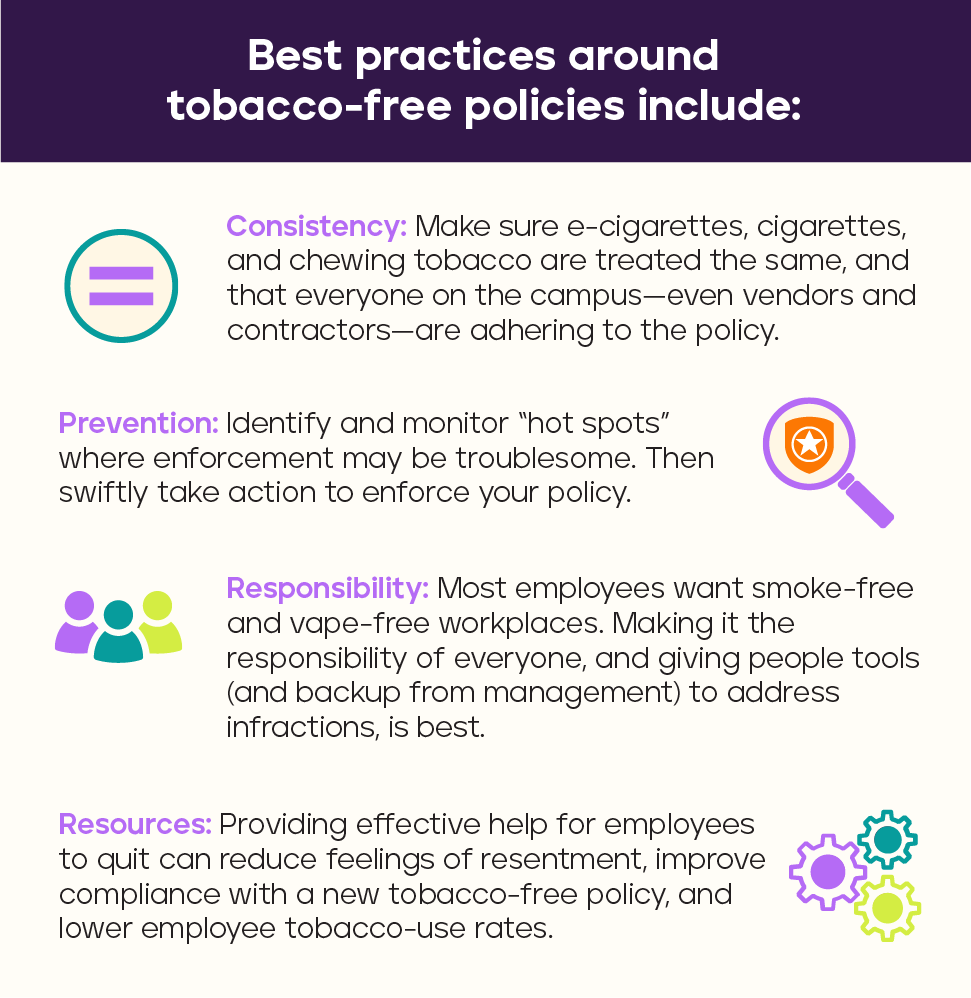Every company is covered with a no smoking policy in the workplace because all states have smokefree laws that cover workplaces, right?
Nope.
In the U.S., only 28 states and the District of Columbia have comprehensive smokefree laws that prohibit smoking in all public places and workplaces.
The good news: In the past 2 years, some states with comprehensive smokefree laws have closed additional loopholes in their laws. Ohio, for example, added e-cigarettes to its comprehensive smokefree law in 2021.
The bad news: People in 22 states remain unprotected from secondhand smoke in at least some public places and workplaces.
In addition to reduced secondhand smoke exposure, the benefits of smoke-free policies in indoor public places, such as workplaces, are plentiful.
To close the gaps in state laws, employers can help by implementing a well-crafted, comprehensive no smoking policy in the workplace.
Key considerations for no smoking policy in the workplace
Research shows smoking bans (no smoking allowed at all) are more effective than smoking restrictions (smoking allowed only in certain areas) in lowering exposure to secondhand smoke in the workplace. Smoking bans are also more effective in reducing the number of employees who smoke.
However, whether your company is ready to go tobacco-free depends on the setup of your property and the impact tobacco has on productivity. For example, if people would have to drive 15 minutes to get outside the grounds to smoke, you need to weigh the impact on productivity against the possible impact of providing designated smoking spots.
Here are a few other common questions we receive about how to create a no smoking policy in the workplace that sticks:
Should I treat e-cigarettes in the workplace differently than cigarettes?
It’s helpful to review state laws in terms of specific regulations, but in general, there should not be any exceptions made to tobacco-free policies to allow the use of e-cigarettes. To learn more about workplace considerations with e-cigarettes, download “5 Things Employers Need to Know Now about E-cigarettes”
How do I enforce a no smoking policy at work? Who is responsible for enforcing the policy?
Most organizations find that placing the burden of enforcement solely on security staff is impractical. Instead, they ask and expect all employees to take part in enforcing the policy.
However, not everyone will be comfortable approaching people who are violating the policy.
To alleviate this anxiety, offer training and “how-to” resources to help your staff speak to individuals in a non-confrontational manner. This might include, for example, providing scripted messages so employees can simply read off cards.
You may also want to provide print materials (cards or brochures) with policy information and cessation resources that can be handed out without engaging smokers in debate.
What are strategies that make a tobacco-free policy successful?
Smoking policies that are clear and enforced can be effective, but they’re even more impactful when paired with an evidence-based tobacco use cessation program.
Next steps with a tobacco-free workplace policy
By implementing a tobacco-free policy at work in combination with the right quit-tobacco program, you can reduce the number of people who use tobacco. You can also improve the quality of life for your employees.
For more insights on how to best implement—and enforce—a no smoking policy in the workplace, download “Tip Sheet: Tobacco-free Policy in the Workplace—Clear Answers for Tough Questions.”
To learn more about the EX Program as a proven digital program that gives tobacco users the skills the confidence to quit, please visit our Program page.










